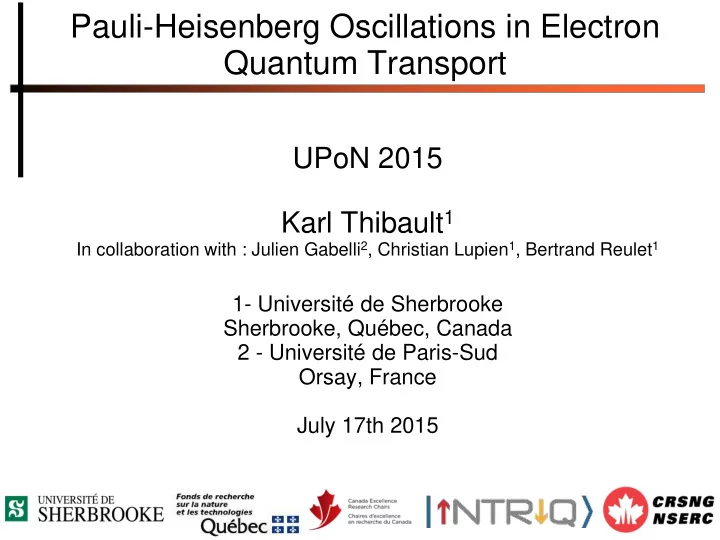

Pauli-Heisenberg Oscillations in Electron Quantum Transport UPoN 2015 Karl Thibault 1 In collaboration with : Julien Gabelli 2 , Christian Lupien 1 , Bertrand Reulet 1 1- Université de Sherbrooke Sherbrooke, Québec, Canada 2 - Université de Paris-Sud Orsay, France July 17th 2015 1 1
Outline • Motivation • Method • Sample and Experimental set-up • Results • Interpretation • Conclusion
Motivation Theory of quantum transport predicts that electrons are emitted regularly each 1 . 1. Lesovik, G. B. & Levitov, L. S. Noise in an ac biased junction : Nonstationary Aharonov-Bohm effect. Phys. Rev. Lett. 72, 538 – 541 (1994).
Method Goal : Measure the current-current correlator in the time domain and show that . Method : Measure the noise spectral density vs frequency with a very large bandwidth.
Tunnel junction
Tunnel junction Normal-metal – Isolator – Normal-metal • Classical regime : current is a succession of uncorrelated random impulses current follows a Poisson distribution shot noise : S = • Quantum regime : Correlations appear
Experimental set-up Tunnel junction
Noise temperature Bruit à l’équilibre (Johnson In general, we express the spectral density of current-current fluctuations as a noise temperature :
Thermal noise : V=0 Vacuum noise
Vacuum noise
Shot Noise Vacuum noise
Time-domain : Equilibrium (V=0) Fourier Transform Diverges!
Time-domain : Shot noise (V≠0) Fourier Transform Since the quantum part diverges, we need to substract it :
Fourier Transform Shot noise (V≠0) Thermal decay caused by temperature
Oscillations in aaa.
Interpretation using Pauli and Heisenberg principles
Conclusion • We have measured the current-current correlator in time domain and shown that it oscillates with a period . Future Work • Measuring in a device where the are other intrinsic time scales (like a diffusive wire, where -- is important). • Measure this correlator in the non-stationnary regime.
Thank you! Questions?
Calibration What we actually measure is : Gain of the system , Amplifier Noise Problem : Method : classical limit/Schottky formula
Spectral density before calibration
Calibration – Gain of the measurement system
Calibration – Noise temperature of the measurement system
Recommend
More recommend